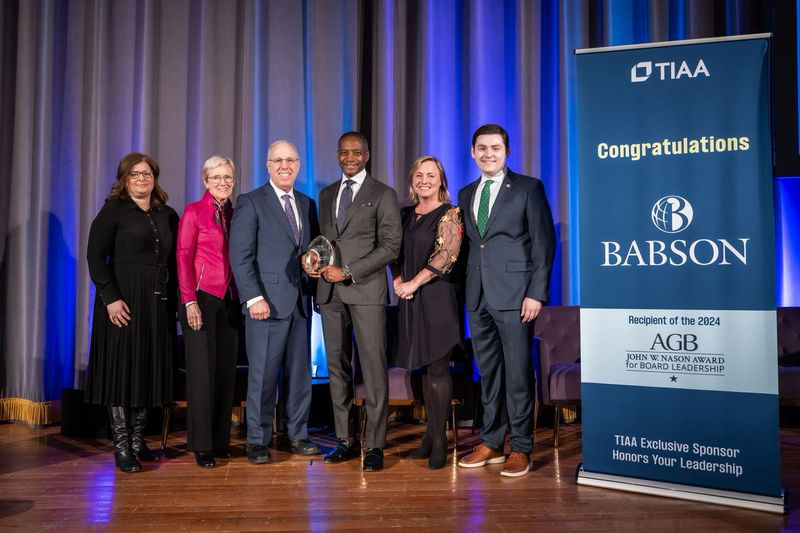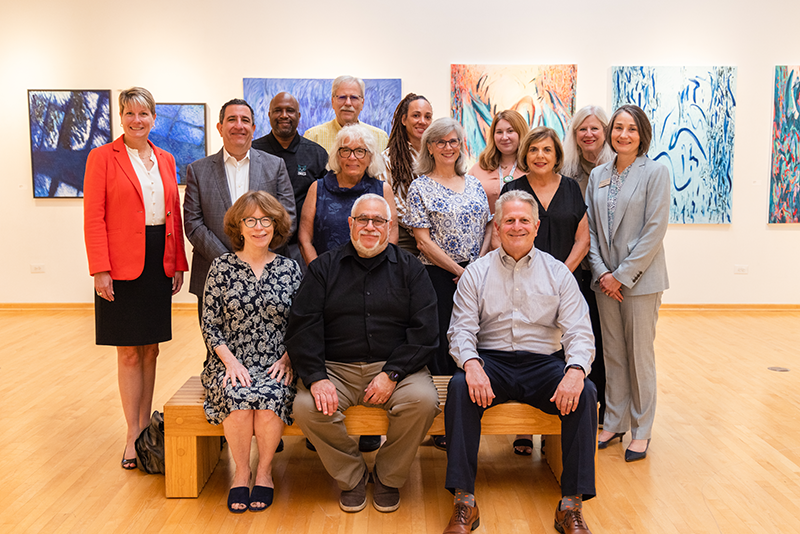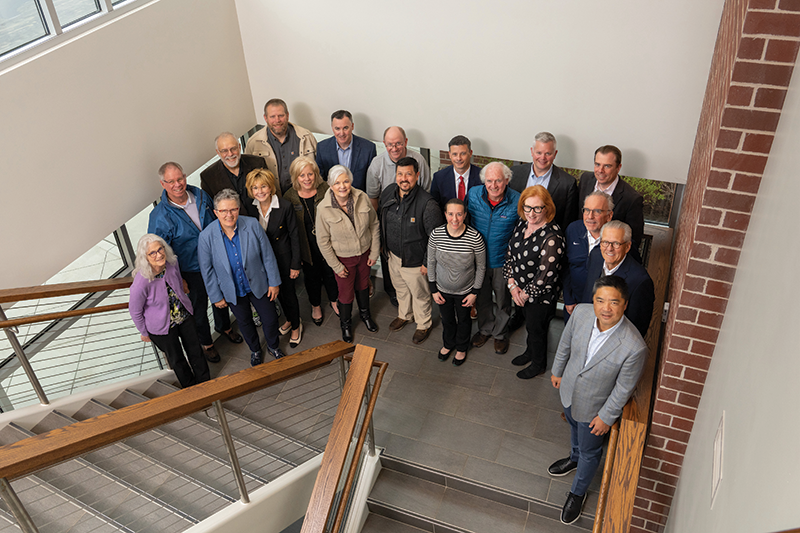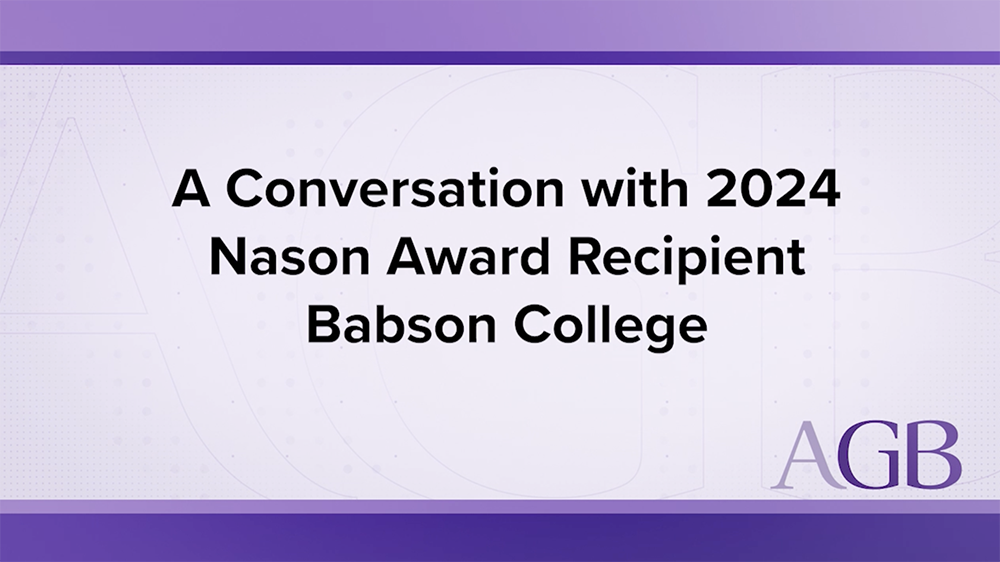
Each year, AGB honors higher education boards that have demonstrated board excellence. These are the four recipients of the 2023–2024 AGB John W. Nason Award for Board Leadership, an honor for trustees who have demonstrated backbone, foresightedness, and determination in fulfilling their role as the financial stewards of their institutions’ future as well as their current course. The Nason Award, established in 1992 and presented in partnership with TIAA, invokes the example of its namesake, John Nason (1905–2001), the Swarthmore College president who during World War II led the effort to find places at 600 colleges and universities for nearly 4,000 American students of Japanese ancestry who’d been interned in relocation camps.
What makes a higher education governing board great?
It might be helping their institution weather an enrollment crisis or taking a hard look in the mirror at itself and its performance. It could be having the patience to persevere through the ups and downs of finding suitable partners for big town-gown projects, or the moxie to say, “Yes, we’re good—but let’s get better.”
That’s what the four recipients of the 2024 John W. Nason Awards for Board Leadership did to stand out among the dozens of college and foundation boards that vied for recognition. Each demonstrated exceptional leadership and initiative to win the laurels bestowed by AGB in partnership with TIAA, in a tradition that began in 1992.
“Like presidents and other high education leaders, governing boards are constantly looking for inspiring stories to celebrate, emulate, and reflect on,” said Ellen Chaffee, AGB interim president and CEO, in announcing the honors for the governing boards of two colleges and two foundations: the Babson College Board of Trustees, the Saint Peter’s University (NJ) Board of Trustees, the Oakton (IL) College Educational Foundation Board of Directors, and the University of Wisconsin–Eau Claire Foundation Board of Directors.
The Nason Award bears the name of the college president who spearheaded the effort that released more than 4,000 Japanese American students from internment camps to resume their studies on campuses across the nation in World War II.
Here are the stories of what these four exemplary boards did.

Left to right: TIAA Representative Janet Lorden, Ellen Chaffee AGB, President Stephen Spinelli, Jr. PhD, Jeffery S. Perry (BOT Chair, Babson College), Kelly Lynch (Babson’s Senior Vice President) and Edward W. Cullinane (Babson, Manager of Governance Affairs) accept the Nason Award at AGB’s National Conference on Trusteeship in March 2024.
Credit: JESS GALLO/@HELLOATLASMEDIA
Babson College and Its Board Aim for Greatness
If any institution of higher education in America were to recognize the importance of having a strong board of trustees, Babson College would sit high atop that list. Its lofty reputation rests on its success in achieving its mission, imbuing both undergraduate and graduate students with the passion and skills to become entrepreneurs. Although the college offers ample courses in the liberal arts, all students earn a bachelor’s degree in business administration and learn to tackle challenges with the mindset of an entrepreneur.
Babson has not stood aloof from the challenges facing private colleges and universities. With the help of its Board of Trustees the college is pursuing a bold “greatness agenda” to enrich the student experience and to give concrete form to the ideal of lifelong learning for its students and the executives who flock there for training. Beyond the campus outside Boston, Babson faculty members work with thousands of teachers and students in dozens of countries “to empower learners anywhere to create lasting economic and social value for themselves, their communities, and the world,” according to its strategic vision statement.
“We’re a very aspirational community. Whether we’re a point ahead or behind, we play like we have to score. I think that’s partly because we’re so focused as a business specialty school,” said President Stephen Spinelli, Jr. “We’re looking for the next challenge, and we can’t get comfortable.”
Jeffery S. Perry ’87, chair of the Babson Board of Trustees, was first drawn to tackling those challenges as an Illinois teenager, when he got to attend a one-week summer program at Babson for Black and Latino high school students. “It was such an inspirational experience for me,” said Perry, who later changed plans to head to an Ivy League university and, after earning an MBA at Harvard Business School, embarked on a three-decade career as a management consultant.
Perry joined the board of his alma mater in 2016 and, on becoming chair in 2021, placed special emphasis on how the board could more effectively play its role in shared governance with the administration and faculty. “We made a fundamental decision early on not to be a board that focused exclusively on our fiduciary role but to balance also being involved in strategic and generative conversations,” he said.
That allowed the 30 trustees—almost all alumni—to “bring their perspectives, life experiences, and knowledge to the table in a way that creates more value for the college…as opposed to an environment where you’re just reviewing documents or things that are fully baked,” said Perry, who now heads his own strategic consulting firm, Lead Mandates LLC.
“We talk a lot about balancing those roles across oversight, insight, and foresight. Staying in that zone keeps us from either micromanaging on the one hand or not being a rubber stamp on the other hand,” he said.
The board began devoting a half-day of each meeting to trustee education and development, led by the trustees themselves. With shared governance at top of mind, 54 faculty were invited to participate in various ways at the October 2022 meeting, as Babson embarked on what it calls its agenda for greatness.
The board, the president, and his team created a shared greatness agenda that included remaining a leader in entrepreneurship education, advancing diversity and inclusion, “future-proofing” the financial business model, and continuing to build the college’s global reputation. Almost 30 percent of the 2,800 undergraduates and half of the 1,200 graduate students are international.
Babson set a goal of raising $300 million when it launched a Centennial Campaign in 2019, which it later raised to $500 million. As it soared past the half-billion-dollar mark, the trustees raised it again, to $750 million. They also extended the contract of Spinelli, the president since 2019 and a role model for entrepreneurship. He had cofounded Jiffy Lube International, the quick oil change empire, and was its largest franchise operator before switching careers to academia with a master’s degree in business administration from Babson and a doctorate in economics from Imperial College, University of London. He served for 14 years on the Babson faculty and as vice provost, then for 12 years as president of Philadelphia University and then chancellor of Thomas Jefferson University, before returning to Babson at the dawn of its second century.
As he had done in the franchise world, Spinelli thought big. In 2022 the college leadership, including the board now chaired by Perry, began an intensive, year-long effort to define greatness and chart its course for the future. In close collaboration with the President’s Council and with the faculty representatives on board committees, the trustees endorsed a blueprint for improving the student residential experience and making lifelong learning a college hallmark and reality. The most tangible part of the lifelong learning plan was the conversion of the former executive education center into a 150,000-square-foot center called the Herring Family Entrepreneurial Leadership Village, with classrooms, labs, student housing, dining, and space to incubate business start-ups and other partnerships with industry. The Village “is about where learners can go and get really fired up about entrepreneurship,” the president said.
Perry, who has devoted his career to helping businesses and executives improve their performance, also sought to ensure that his partners on the board “get value out of actually being a trustee.”
“In all of our meetings, we block out time for trustee education on areas that are really relevant to the school,” he said, including sessions on artificial intelligence, lifelong learning, and tech entrepreneurship. “That allows them to be a better trustee when the school is grappling with how to incorporate or address those issues going forward.”
Spinelli said the bond between the board, the management team, and the faculty was “forged by fire” during the COVID pandemic. “It was so intense and required a community response, and the board was an important part of that response, in their generosity and their management wisdom.”
Perry experienced that as a Babson parent, too, with his undergraduate son (now an alumnus) returning home to Lake Forest, Illinois, in March 2020, then flying back to Massachusetts six months later when Babson was among the first colleges to bring students back for hybrid classes both face-to-face and online.
“Quite frankly, I think it also demonstrated the innovation and creativity that we teach our students and talk about in the classroom, in terms of taking a situation and figuring out what’s the best way to approach it based on the resources that you have,” said Perry. “It brought to life what Babson teaches its students.”
Babson is determined to extend its reach far beyond campus. It has an online summer program to teach entrepreneurship to high school juniors and seniors, and it trains teachers in dozens of other countries. One enrollee in a lifelong learning program is 88. “And if you live to 98, we’ll take you then, too,” said Spinelli, and it offers executive education on campus, virtually and in hybrid formats. “We believe that you have to have all three to have a full business model for lifelong learning.”
“If you look at what is required to be successful in life, successful in business, successful in any endeavor, it’s the notion of continuous learning. It’s not like you just get an education and that’s it,” said Spinelli. “Babson’s ability to be a partner along that journey for our learners is critical to the strategy going forward.”
He believes every institution would profit from developing an agenda for greatness.
“We’re not saying greatness is exclusive to Babson. We’re saying that as a community, this is what we really believe in and these are things we have to do to be great at our mission,” Spinelli said. “We came together with a common vision. It’s a very fulfilling communal experience. I’d recommend it to everybody.”
The board chair shares that sentiment.
“We exist in a macro environment in higher education where you hear stories of declining enrollment, affordability issues, suboptimal outcomes, even questions about the value of a higher education,” said Perry. “The approach that we’ve taken is to focus on positioning ourselves as positively as possible and saying: Here are the beliefs, values, and perspectives that will propel Babson forward.”

Left to right: Katherine Sawyer (chief advancement officer/foundation executive director), Scott Hurwitz, Ruben Howard II, Carl Costanza (immediate past president, in back), Kathy Lichtenstein (in front), Regina Holloway (back), Catherine Leonard (front), Jessi Moon (foundation associate executive director, back), Cindy Veremis (front), Joan Richards (back), Joianne Smith (college president)
Credit: KAYLA RUCHTI
Fast Learners on the Board of Oakton College’s Educational Foundation
When Oakton College in Des Plaines, Illinois, selected then vice president of student affairs Joianne Smith to become its fourth president in 2015, she stepped into a difficult situation: the state of Illinois was in the midst of a two-year budgetary impasse that slashed funding for its public colleges and universities along with all social services. Oakton basked in its reputation as one of the country’s top community colleges, but the impasse in Springfield posed an extraordinary challenge. “Because Oakton had a strong, solid foundation, we were able to weather some of those storms better than some of our peers, but we were not immune to the challenges, that’s for sure,” said Smith.
Oakton has both a locally elected, fiduciary Board of Trustees and the separate Board of Directors for the Oakton College Educational Foundation. “They had a relationship, but it wasn’t as connected as I thought it could be,” she recalled.
The Foundation Board of Directors was by its own description “an adequately performing charitable partner” that managed the investment performance of its assets and awarded some scholarships and faculty and staff recognition awards. Yet, most of the 20 outside members were only minimally engaged in the work and the board had no mission statement. “The word ‘strategy’ was essentially absent from the board’s vocabulary,” the board said in its application for the Nason Award.
That changed rapidly after 2018 when the foundation recruited a new executive director, Katherine S. Sawyer, an experienced fundraiser and communications pro who’d served in the same role at another community college foundation and worked for a third in Illinois. Sawyer, also the college’s chief advancement officer, was already deeply involved with AGB and cognizant of all its resources for governing boards.
Within months she prepared and presented to the board a blunt, detailed assessment of its performance and a blueprint for turning it around. As the application noted, “nothing was sugar-coated.” Far from bristling at the criticisms, the board enthusiastically embraced Sawyer’s recommendations for sweeping changes in governance, board development, planning, staffing, fund-raising, presidential engagement, training, and other activities.
The foundation board joined AGB, engaged AGB consultants for brainstorming sessions, and—perhaps most significantly—began sending three directors each year to the AGB Foundation Leadership Forum to learn best practices and network with peers.
“Switching to being a strategic board took a little time because it (requires) a reorientation of thinking,” said Murray Sprung, a certified public accountant who joined the board in 2016 and became president six years later. “Our board has endeavored to establish policies and practices that are comparable to those of the country’s highest-performing higher education charitable boards.”
Now it’s setting an example for other foundations. Julie Fenton, the board vice president and president-elect, joined Sawyer and colleagues from Salem State University in Massachusetts in presenting a session on good governance at the Foundation Leadership Forum in Los Angeles in January 2024 that drew a standing-room-only crowd. “It was very, very exciting that people would want to hear more about our journey,” said Sawyer.
“We covered a lot of things that people in the room were interested in, like how to run a good board meeting to make sure you minimize the boring and pay more attention to the exciting and … having conversations so you all can agree on what your board is trying to accomplish,” said Sawyer, who wears the hats of executive director of the Oakton College Educational Foundation and associate vice president of marketing and communication and chief advancement officer of the college.
“People came up afterwards to talk with us,” she said. “It felt like we’re all in this together. We, as community colleges, are a part of this greater good of trying to improve higher education in this country.”
It was Fenton’s second time at the forum. “It’s so inspiring and invigorating,” said the retired attorney. “Board members really come back with all the lights burning and a great desire to implement the things that they heard. It’s very validating because we’ve all come back and said, ‘Okay, we’re doing the right things. We’re headed in the right direction.’”
Fenton said Sawyer’s original frank assessment laid out a road map “that basically became our to-do list” for the next three years.
The board developed its first strategic plan, rewrote the bylaws, and adopted a mission statement that succinctly said it all: “To Enable Student Success.” It also developed a Memorandum of Understanding with the college “to clarify roles, expectations, and spirit of the partnership and cooperation.” It arranged the first joint meetings with the college Board of Trustees and college leadership.
The board also lent its strong support to the college’s efforts to promote a shared understanding of diversity, equity, inclusion, justice, and belonging and to advance racial justice.
The community college serves 7,000 for-credit students and tens of thousands of non-credit students on its 147-acre main campus in a forest preserve in Des Plaines, a second campus in Skokie (about 20 miles north of Chicago), and online. More than half the students are minorities.
With an investment portfolio approaching $20 million and an expanded staff, the board increased donor engagement and fundraising by 165 percent and boosted scholarship support by 54 percent since 2018. During the pandemic it purchased 250 Chromebooks for students who didn’t have laptops of their own, provided $57,000 in emergency funds, and underwrote training for hundreds of contact tracers. It also purchased $10,000 worth of face shields for first responders and helped launch an academy to support Black male students, historically underrepresented at Oakton.
“We recognized even more than we had previously, the fragility of many of our students’ lives, how transportation, childcare, housing, and food insecurity are often the things that get them off track. It’s not the academic stuff,” said Smith.
“We worked with the foundation to help our community of donors understand that in addition to tuition and fees being barriers for students, they really need those holistic, wraparound support services to be successful and stay on track,” the president said.
Sprung said that “switching to being strategic board took a little time because it’s a reorientation of thinking. Yes, we were giving out student scholarships before and we’re still raising money for that. But our work has become much more in depth. There’s a lot more reporting and communication with donors, trying to get them committed to provide more funding for the strategic purposes we’re looking at.”
“We ask ourselves, ‘What can we do to enhance our role to support the college and the students rather than just getting money and tracking it?’” the board president said. “There’s a much broader effort to manage our objectives rather than just care for the money.”
Fenton, who joined the board when he witnessed a nephew become an honors student at Oakton after barely eking out a diploma in high school, said the transformation of the board itself is “still in its infancy.”
“The past five years was spent building out our infrastructure to now being outward facing and more strategic,” she said. “What I’m hoping for is a learning curve among our members, and I think everybody is willing to learn how we do this thing, which is to become fundraising ambassadors so we can fund the goals of the college.”

Left to right: Ellen Chaffee, Janet Lorden, Virginia Bender ’78, Ph.D., special assistant to the president for institutional planning at Saint Peter’s University, Eugene J. Cornacchia, Ph.D., president of Saint Peter’s University, Kenneth Moore, CFA ‘91, chair of the Saint Peter’s University Board of Trustees accept the Nason Award at AGB’s National Conference on Trusteeship in March 2024.
Credit: JESS GALLO/@HELLOATLASMEDIA
The Trustees of Saint Peter’s University Ran With the Ball
At a school with a basketball arena named “Run Baby Run,” it’s no surprise that the Saint Peter’s University Board of Trustees acted fast when undergraduate enrollment at the tuition-dependent Jesuit institution plunged 12 percent during the pandemic. Remarkably, while the undergraduate ranks shrank, the graduate student population exploded from 842 in fall 2020 to nearly 1,600 in fall 2023.
Enrollment is now at a quarter-century high at the college in Jersey City, New Jersey, a 12-minute ride on rapid transit from downtown Manhattan. (Admission brochures tout Jersey City as New York City’s “sixth” borough.)
Eugene J. Cornacchia, president since 2007 and a member of the faculty for more than four decades, has witnessed tremendous changes over those years, including the attainment of university status. Cornacchia, who is now retiring, said, “I dug out my old gradebook recently and was flipping through the pages looking at the names. They were Irish, they were Italian, they were German, they were Polish, sprinkled in with fair number of Latinos and some African American students, but mostly white.” Most hailed from surrounding Hudson County and suburban areas of New Jersey.
By 1998, Saint Peters was officially designated a Hispanic-serving institution by the U.S. Department of Education and today two-thirds of students are Hispanic, Black, or Asian-American. (The undergraduates still come mostly from the Garden State.) Half qualify for Pell Grants.
One thing that has not changed is the Jesuit emphasis on cura personalis or care for the development of the whole person and pursuit of the magis, the signature Jesuit principle of pursuing the greater glory of God and excellence in all things.
Kenneth M. Moore ’91, chair of the Board of Trustees, said he experienced that cura personalis himself, growing up in Jersey City and attending Saint Peter’s Prep and then Saint Peter’s College on a full scholarship. “It’s not just about academics. That’s a big part of it. But the culture of this institution is about caring for the entire individual,” said Moore, executive vice president of Jennison Associates, a financial investment management firm.
Saint Peter’s, which celebrated its sesquicentennial in 2022, received an American Council on Education Award for Institutional Transformation in 2018 for responding “to challenges in innovative and creative ways that allow the institution to thrive.”
That accolade “was largely for how we came through the Great Recession and then moved forward. I feel like every time we turn around there’s another challenge coming our way,” Cornacchia said with a smile.
The pandemic was the next bear to wrestle with. The board sprang into action, leading the development and implementation of a plan of action to identify short-term strategic priorities, diversify enrollment and revenues, launch financial recovery initiatives, and enhance governance capacity.
“We’ve always been blessed with a very engaged board, always very attentive to the needs of the university and dealing with the larger strategic issues,” said Cornacchia. “But the pandemic forced all of us to come together look at a more granular level at the issues that we had in front of us, whether it was finances, enrollment, or state and federal covenant issues, (which) many of us probably hadn’t really dug deep enough into before. The pandemic really brought a lot of things to the surface.”
The expertise the board possessed in finance, real estate development, academics, and other matters “was invaluable as we wrestled with the challenges in front of us during the pandemic,” he said.
When the pandemic hit, the university had just begun work on a five-year strategic plan. In summer 2020 the board held a special virtual planning retreat with the president and senior administrators to discuss both short- and long-term recovery. Out of that, the trustees adopted a three-year bridge plan titled Vitality, Value and Viability: The Saint Peter’s University Strategic Framework for 2021–2024 to respond to both the new realities created by the pandemic and the perilous state of higher education in general.
“At that moment, no one could really figure out how to plan long term because there was such turmoil in the world. Making a five-year strategic plan right then didn’t seem too rational,” Cornacchia said. The purpose of the bridge plan “was to get us from where we were to a point where we could then go back to building a longer-term strategic plan once the dust settled and we knew what the new normal would be.”
Moore, who joined the board in 2018 and became chair in 2023, said the particulars of the Vitality, Value and Viability bridge plan weren’t “brand new. It’s just we were able to move quickly and be adaptable.”
The board’s nine committees set the pace for the turnaround. The Academic Affairs Committee supported the provost and deans in shaping a dozen new, market-responsive academic programs, including degrees in business analytics, data science, and cybersecurity. Finance helped shape strategies to deal with cash flow issues due to reduced enrollment and helped to fashion a $75 million debt restructuring plan.
Meanwhile, more dividends came from an unexpected source: the Peacocks basketball squad, which in March 2022 became the first No. 15 seed—next to the bottom—to knock off three opponents and make it to the Elite Eight in the NCAA March Madness tournament. The year after the Cinderella team’s run, applications jumped 59 percent and gifts and pledges nearly tripled. The incoming freshman class in 2023 was 20 percent larger than the previous fall.
“People know us now,” said Cornacchia. “You can spend as much money as you want on marketing, but unless you do something like that run that gets you literally hundreds of thousands of social media impressions and attention on national media, you just can’t penetrate it.”
Despite supply chain challenges, the Finance and Facilities Committee oversaw the completion of several major capital projects during the pandemic, including the launch of Run Baby Run Arena, the name a nod to the slogan of a 1968 Peacocks team that averaged 94 points a game. A player from that era was the principal donor.
“It wasn’t easy” to pull off those multiple, overlapping projects, Moore said. “You always wish everything could go perfectly, but it doesn’t. It’s not about the planning. It’s about how you react when something comes up.”
The board schooled itself on effective governance and set its cap to get there. The nine standing committees “updated their statements of purpose to clarify their duties and also to reflect how they advance Saint Peter’s mission, and in particular, the social justice and diversity, equity, and inclusion goals,” the board said. It used consent agendas in full board meetings to allow more time to focus on strategic priorities and fiduciary matters.
“It was terribly painful in the old days” before consent agendas, Cornacchia recalled with a laugh. “With every committee, it was just a recitation of what was already in the board books—well-intentioned, but not really helpful in getting to the meaty topics that needed more attention.”
Saint Peter’s has momentum, but its leaders recognize that they need to keep running hard to meet the challenges that confront liberal arts institutions everywhere.
“No. 1, we have to optimize what we’re good at. We’re not trying to do revolutionary change in anything. We have a 150-year track record of successfully staying true to our Jesuit mission and educating predominantly first generation and, right now, predominantly minority students,” said Moore. “That’s the core of what we do.”

Front row, left to right: Sharon Masek, Jill Muenich, Christine Rice, Christine Smith, Kimberly Underwood, Amanda Hill-Hable, Mary Jo Quinn. Back row, left to right: Chops Hancock, Ray Skwierczynski, Jason Wudi, Brian Elwood, Erik Hendrickson, Bill Sparkes, Jason Craig, Terry McMahon, Brandon Riechers, Jeff Johnson, Jeff Lang, Keith Donnermeyer, Eric Wan.
Credit: UW–EAU CLAIRE
University of Wisconsin–Eau Claire’s Foundation Builds Up Not Just a Campus but a City
On the day of his inauguration as chancellor of the UW–Eau Claire in 2013, James C. Schmidt challenged the community to be guided by three core values as it went about its work: public good, audacity, and joy. Chancellor Jim, as everybody calls him, has never wavered from that path.
He found a strong ally for the audacity part of his agenda in the UW–Eau Claire Foundation, which has formed public-private partnerships that are remaking the campus and its hometown on the banks of the Chippewa and Eau Claire rivers. The crowded, 314-acre campus had not seen state-funded construction for decades before a new academic building opened in 2013. Space for student housing was at a premium.
Things had begun to change at the 60-year-old foundation well before Schmidt’s arrival. It underwent a metamorphosis after Kimera Way was hired in 2001 to lead the university’s first capital campaign. She became the foundation’s president and later its CEO. “Until shortly before I came on board, the largest gift needed to qualify for the President’s Club was $150, and they had just created a major donors’ club to recognize cumulative contributions of $10,000 or more,” she recalled. “They were just dipping their toe in the water. We really had to elevate the expectation and sights of what the foundation’s role for the university could be.” Subsequently, the foundation launched its first major campaign, raising $30 million for scholarships and programs.
That was just the start. In 2010 the university unveiled its first Campus Master Plan, a 20-year blueprint that envisioned new buildings on campus and facilities shared with other civic players elsewhere. To pull that off in an era when state funding was acutely constricted—state appropriations for public higher education fell 23 percent over two decades—the foundation realized it needed to get into the real estate game itself.
The foundation formed a real estate committee and a limited liability corporation and then purchased for $1 million a convent nestled in woods three miles from campus, which the university spent $5 million converting into 48 single rooms for students and a childcare center. Next the foundation was approached by a local developer to partner in acquiring prime real estate downtown for what became the Pablo Center at the Confluence, an arts and theater facility, with an adjacent private building that had five floors of student apartments atop retail spaces on the ground floor. The board created the Blugold Real Estate Foundation to acquire and develop property for the benefit of the parent foundation and the university. The city credits the nonprofit Pablo Center with sparking $250 million in additional economic development on both sides of the Chippewa. Blugold Real Estate next partnered on another commercial mixed-use condominium project that added rooms for 200 more students.
Meanwhile, the spigots opened in Madison, where the state legislature approved construction of what will be a $340 million science and health sciences building on the site of two deteriorating dorms. When it opens in 2026, it will be the most expensive building ever constructed by the state. UW–Eau Claire is the seventh largest of Wisconsin’s 13 public universities. Enrollment approached 10,000 in fall 2023.
Eric Wen, chair of the Foundation Board of Governors, said Schmidt “is an inspirational leader, but he’s also practical in working through challenges. Having alignment between his vision and the board’s vision on where we should [focus] our time and resources to grow has been critical.”
But those challenges have been significant, especially with the university’s investment in another consequential partnership that was envisioned in 2014 and now is nearing completion: the Sonnentag Event Center and Fieldhouse, which will be the largest event venue in northwestern Wisconsin. It required approval by the city and the UW Board of Regents and even passage of a referendum by the students to boost their activity fees by $90 per semester toward the lease of the replacement for the worn, un-air-conditioned Zorn Arena, which for decades hosted not only basketball games but also political rallies and graduation ceremonies. (The new center will sit on 21 riverfront acres donated to the Blugold Real Estate Foundation by alumni philanthropists John and Carolyn Sonnentag, whose gifts to the university total $70 million, including $40 million to build the event center and fieldhouse.) The center is one component of a $120 million complex on a former industrial site once occupied by the Sonnentags’ concrete and gravel business.
Originally the university and the local YMCA were going to build and share the new event center but three years in, the Y pulled out of the partnership. A new partner stepped in to bring the center to fruition: the Mayo Clinic, which already had a significant presence as a health provider in Eau Claire. It will open the Mayo Clinic Health System Diagnostic Imaging and Sports Medicine Center at the complex alongside the UW–Eau Claire Center for Health and Well-Being. Mayo researchers also have joint projects with UW–Eau Claire faculty.
There were anxious moments when the fates of both the Pablo Center and the Sonnentag project were up in the air. “We joke that we were on Plan Triple Z before they came to pass,” said Way. “There was a lot of local opposition to the arts project. I think we attended over 60 public meetings and had to survive two referendum votes, but we actually got public funding from both the city and county.… The willingness to have the patience and shift when you had to shift helped us.”
Today the foundation, which once singled out donors who made $150 gifts, is wrapping up a $150 million capital campaign.
Wan, the board president, is a 1996 alumnus originally from Toronto who was attracted to UW–Eau Claire to play hockey and graduated in 1996 with a degree in management information systems. He is the chief growth officer of a California-based pharmacy benefit manager, Liviniti. He joined the foundation board in 2011 when it was already bringing in new members skilled “not only in real estate but also legal, finance, and governance. It really upped the game of the board because we were doing such impactful projects.”
They had a willing and able partner to work with in Chancellor Jim.
“It frustrates me when I see colleagues leading other institutions put up their hands and say, ‘Hey, there’s no money. We’re just going to have to make do with less.’ I’ve always refused to take that path,” Schmidt said.
Christopher Connell is an independent journalist and former education writer for the Associated Press. He is also the author of the recent AGB report, Top Strategic Issues for Boards 2024–2025.





